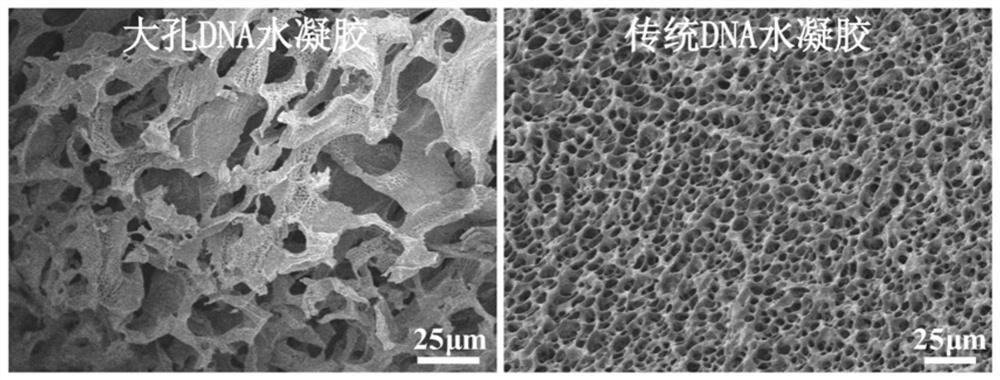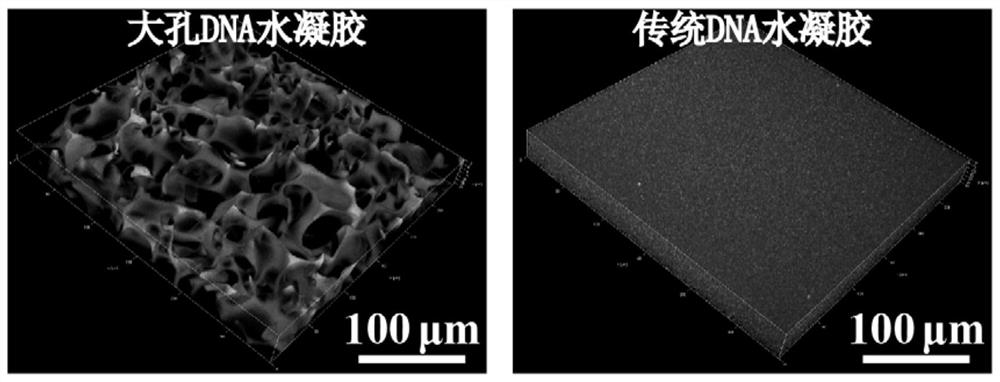Preparation method of high-strength DNA hydrogel with macroporous structure
A hydrogel, high-strength technology, applied in the field of DNA hydrogels, which can solve the problems of inability to respond and improve mechanical properties
- Summary
- Abstract
- Description
- Claims
- Application Information
AI Technical Summary
Problems solved by technology
Method used
Image
Examples
Embodiment 1
[0032] A preparation method of DNA hydrogel with macroporous structure is as follows:
[0033] 10mM / L Tris-HCl at pH 8.0, 50mM / L MgCl 2 Adding a final concentration of 2% acrylamide solution in the buffer solution, a final concentration of 1mM / L DNA (1) solution, the reaction solution with N 2 Carry out deoxygenation for 5 minutes. After deoxygenation is completed, add APS with a final concentration of 0.4% and TEMED with a final concentration of 0.2%. After that, quickly place the PCR tube containing the reaction solution at -20°C to make the polymerization reaction at low temperature. next. After the polymerization reaction is completed, the cryogel is thawed at 4°C to melt the ice crystals, and a DNA hydrogel with a macroporous structure is obtained. The obtained DNA hydrogel is soaked in a buffer solution to remove unreacted monomers and initiators. agent.
Embodiment 2
[0035] A preparation method of DNA hydrogel with macroporous structure is as follows:
[0036] 10mM / L Tris-HCl at pH 8.0, 50mM / L MgCl 2 Adding a final concentration of 2% acrylamide solution in the buffer solution, a final concentration of 1mM / L DNA (1) solution, the reaction solution with N 2 Carry out deoxygenation for 5 minutes. After deoxygenation is completed, add APS with a final concentration of 0.4% and TEMED with a final concentration of 0.2%. After that, quickly place the PCR tube containing the reaction solution under the condition of -40°C to make the polymerization reaction at low temperature. next. After the polymerization reaction is completed, the cryogel is thawed at 4°C to melt the ice crystals to obtain a DNA hydrogel with a macroporous structure, and the obtained DNA hydrogel is soaked in a buffer solution to remove unreacted monomers and Initiator.
Embodiment 3
[0038] Preparation of traditional DNA hydrogels
[0039] 10mM / L Tris-HCl at pH 8.0, 50mM / L MgCl 2 Adding a final concentration of 2% acrylamide solution in the buffer solution, a final concentration of 1mM / L DNA (1) solution, the reaction solution with N 2 Carry out deoxygenation for 5 minutes, add APS with a final concentration of 0.4% and TEMED with a final concentration of 0.2% after the deoxygenation is completed, and then use N 2 Deoxygenation was carried out for 3 minutes, and then the PCR tube containing the reaction solution was placed at 4° C. to allow the polymerization reaction to proceed. After the polymerization reaction is completed, a traditional DNA hydrogel is obtained, and the obtained DNA hydrogel is soaked with a buffer solution to remove unreacted monomers and initiators.
[0040] The DNA sequence in the DNA (1) solution used in Examples 1-3 is: 5' / Acry / -AAACCTGAATTCAGG, the DNA chain contains a palindromic sequence, and self-complementarity can occur be...
PUM
 Login to View More
Login to View More Abstract
Description
Claims
Application Information
 Login to View More
Login to View More - R&D
- Intellectual Property
- Life Sciences
- Materials
- Tech Scout
- Unparalleled Data Quality
- Higher Quality Content
- 60% Fewer Hallucinations
Browse by: Latest US Patents, China's latest patents, Technical Efficacy Thesaurus, Application Domain, Technology Topic, Popular Technical Reports.
© 2025 PatSnap. All rights reserved.Legal|Privacy policy|Modern Slavery Act Transparency Statement|Sitemap|About US| Contact US: help@patsnap.com



